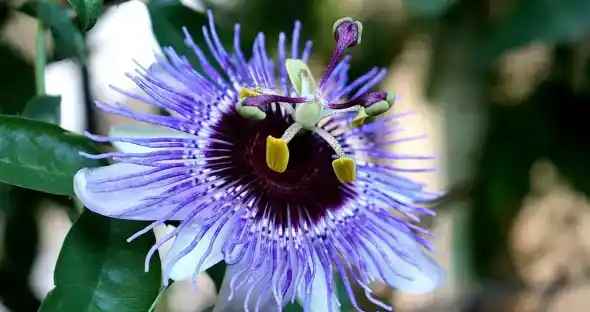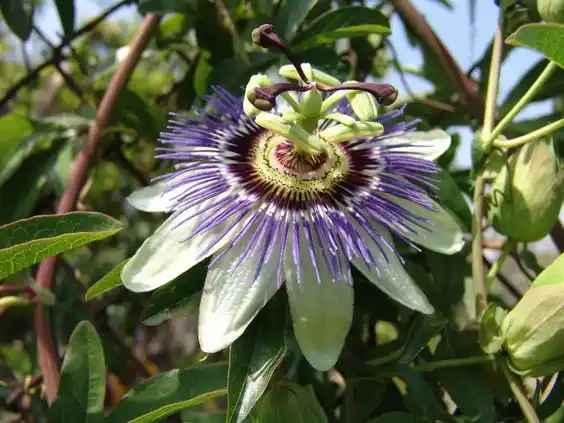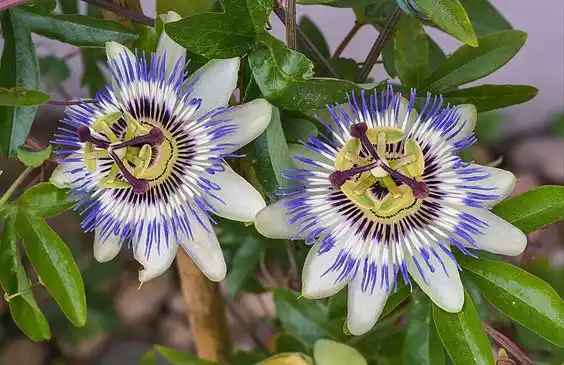Blue Passion Flower Plant- A Complete Guide to Grow, Tips to Care, and Key Facts
Updated on : 29 September, 2024

Are you among those who love gardening and place new additions of plants to enhance the beauty of your terrace or balcony? If so, the blue passion flower plant should be your next addition. Also called the Passiflora Caerulea or Bluecrown Passion Flower, this national flower of Paraguay is grown because of its benefits in terms of health and vastu home plan. But there is more to this. In this blog, we will cover some benefits, tips to grow, key facts, and other essential details.
What is Passiflora Caerulea Flower?

Image Source: Pinterest
The Passiflora Caerulea flower originated in South America and is widely known for its rapid growth. It is characterized by long, twisting tendrils, complimented with white or blue sepals, and a multi-colored look. The fruit grown in this plant is orange-yellow with an oval shape.
It is further characterized by its resilience to cold climatic conditions. The average height of a passionflower is 10-15 feet or more, with a width of up to 6 feet. If you are growing this blue passion flower on your terrace or balcony, then be ready to get regular visitors like birds, butterflies, and bees, further adding exotic features to your space.
One exciting aspect of this plant is the fruit grown can be eaten when ripe, but the taste is quite bland compared to other passion flowers grown worldwide.
Key Facts about Blue Passion Flower Plant
| Basis | Description |
|---|---|
| Other Names | Passiflora Caerulea flower, passion fruit, Jesus flower, etc. |
| Indian Name | Krishna Kamal |
| Originated | South and North America |
| Physical Description | Grows in the form of prostrate vines with grasping tendrils, trees, or shrubs |
| Blooming Season | Summer season |
| Average Growth Height | Up to 30 feet |
| Watering | Once in a week |
| Placement | Place it in a warm location and avoid direct sunlight |
| Medicinal Benefits | Helps to treat anxiety, insomnia, brain disorders, and others. |
| Soil Required | Well-drained soil |
How to Grow a Blue Passion Flower Plant?
One of the reasons why people prefer growing this eye-catching Passiflora caerulea plant is because it enhances the garden's overall look. Moreover, its aroma uplifts the ambience. If grown well, the flower can bring positive vibes to your space. Let us check the step-by-step guide to growing this beautiful blue passion flower passiflora caerulea:
Collect Seeds
Collect its seeds from the passion fruit. Wash them and dry them for a day. You can even buy these seeds online or visit your nearest nursery.
Soaking and Cleaning
Soak well overnight and clean it well the next day. If you find any seeds floating over the next morning, discard them. Clean the remaining ones and throw away the dusted ones.
Seeds Germination
You can do this by placing the seeds on the soil's surface in a small pot filled with soil and manure. Don’t bury these seeds deep within the soil, as they require adequate sunlight to soak them in. Now, wrap the pot to enable the seeds to germinate. You can place this pot in a warm place in your home.
Repot it into a Big Flower Pot
Once you see leaves coming from the seeds, repot them into a giant pot. Choose a suitable location in your terrace or balcony garden to place this flower pot to get adequate sunlight.
How to Grow Passiflora Caerulea Flowers Through Stem Cuttings?
Besides following the above steps, you can grow the bluecrown passion flower plant through stem cuttings. You can do this during the spring season. Here are the steps:
- Cut 15 cm of the length of the stem piece from the vine!
- Clean all the leaves from the bottom of the stem!
- Place all your cuttings in the potting mix!
- Place it in a warm area in your garden.
Tips on How to Take Care of Blue Passion Flower Plant
Taking care of this vibrant Passiflora Caerulea will help its long-term growth. Here are a few steps you can follow-
Water it Weekly
Passiflora Caerulea Flower doesn't require regular watering. It can be maintained in dry climates so that you can water it once a week. However, if placed directly in sunlight, frequent watering is necessary.
Trimming
Trim or prune the plant once a year. The best time to do this is when the plant partially dries. Use the tool to cut down the dried parts to grow new plants.
Apply Fertilizer
Select a premium fertilizer with a balanced ratio of potassium, phosphorus, and nitrogen. Always choose Organic compost.
Offer Support
Since the blue passion flower is a vine, the best location is beside a fence where it will get ample support to grow.
Keep Safe from Pests
If your place has poor air quality and high humidity, there is a high chance that Passiflora Caerulea flower can lead to fungal infections A fungal disease called leaf spot may develop in overly wet plants.
Different Types of Flowers in Passiflora Caerulea
Different types of passiflora caerulea flowers are grown worldwide. Some of these are-
Purple Passionflower
Also called Passiflora Incarnata, this type has a deep purple color and fringed crown. It emits mild sedatives, which can help with anxiety, insomnia, and stress.
Passion Fruit Vine
This fast-growing plant is widely known for its aromatic fruit. The fruit vine flower has a tough outer layer and a seed-filled pulp.
Stinking Passionflower
Another scientific name for this flower is Passiflora Foetida, which has three-lobed leaves and green-yellow flowers. It is widely used in traditional medicine.
Passiflora Ligularis
Also called the Sweet Granadilla, this passion flower is grown mainly in South America. The plant blooms with white flowers and round fruit containing juicy pulp.
Vastu Tips to Place Passiflora Caerulea Flower Plant
In India, the Blue Passion Flower plant is called Krishna Kamal. According to Vastu principles, a passionflower should be placed in the northeast or north to encourage wealth, happiness, and serenity within the home. West and south are directions to avoid.
What are the Medicinal Benefits of Passiflora Caerulea Flower?
Besides vastu benefits, the Blue Passion Flower Plant has medicinal benefits. Some of these are-
- Eating raw fruit can help with digestion. Thanks to its anti-inflammatory properties, using its roots and leaves can also cure gastrointestinal problems.
- In many countries, including Brazil, the flower is used to cure insomnia and anxiety disorders.
- In India, health professionals use this flower in Ayurveda as a natural herb to cure anxiety, stress, and depression.
However, you must remember that this flower contains cyanide compounds that can be dangerous if not extracted well.
Summing it up

Image Source: Pinterest
Growing a blue passion flower plant is like inviting beauty and positivity to your garden and living space. Following the right growing tips, taking care, and using it wisely will help you in many ways and will grow for many years. However, remember to seek expert advice before using it for medicinal purposes.



